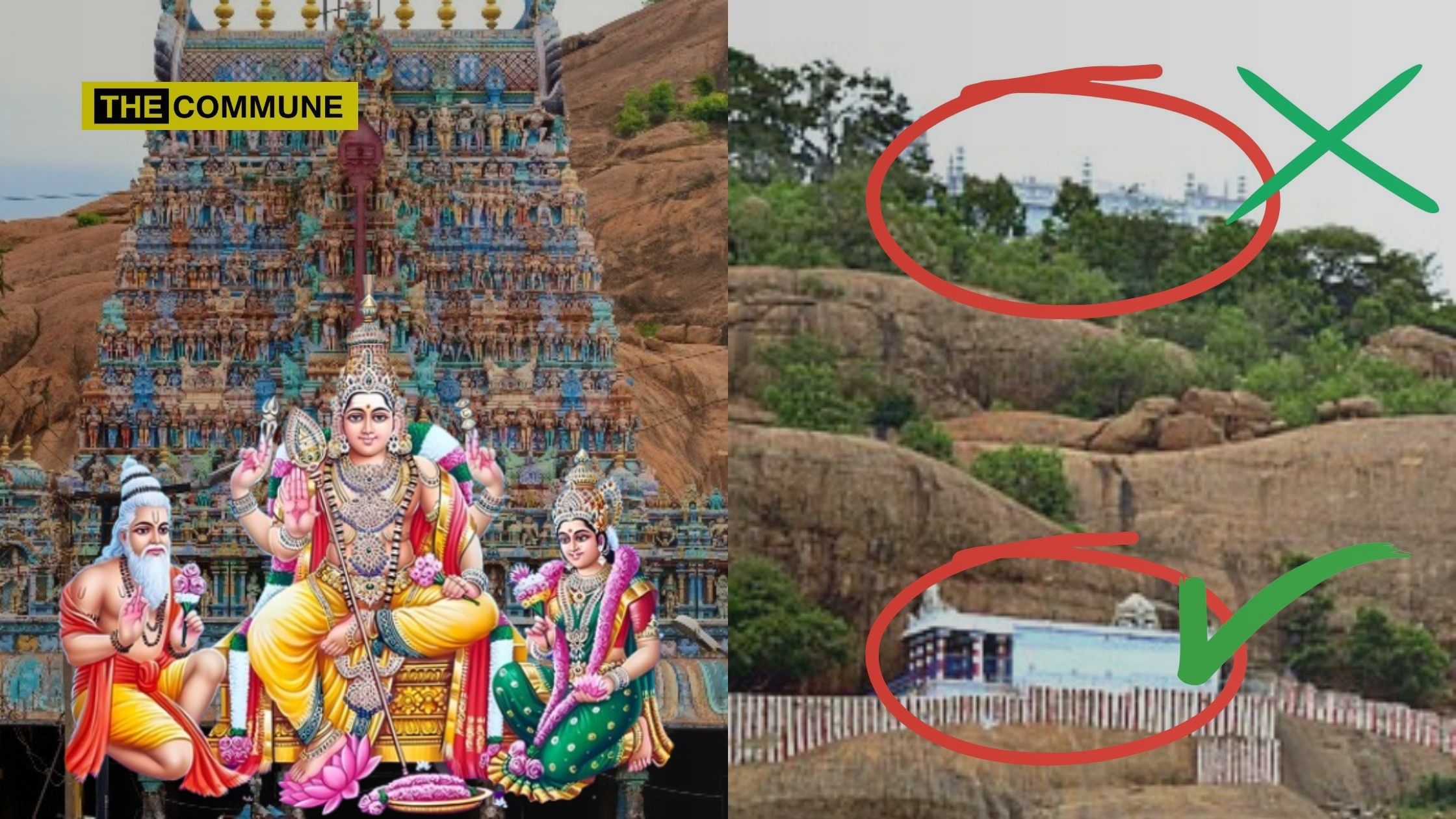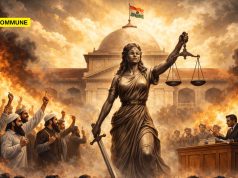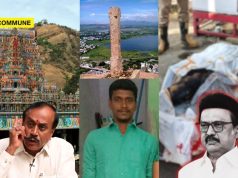
Thiruparankundram hill, along with its adjoining temple, is home to one of Tamil Nadu’s oldest and most revered temples, dedicated to Lord Shiva and Lord Murugan. The Thiruparankundram Sri Subramania Swamy Temple, located in Madurai, is the first among the Aattrupadai Veedu (Six abodes of lord Murugan) temples, as sung by the famous Sangam poet Nakkeerar. Additionally, this temple is a Tevara Sthalam, a revered site in the Tamil Shaiva tradition.
There have recently been claims and counterclaims concerning the alleged rights of Muslims over the sacred hill of Thiruparankundram in Madurai. A group of Muslim protesters assembled in large numbers at Thiruparankundram Hills demanding permission to offer prayers at the uphill mosque claiming the sacred hills as ‘Sikandar Hills‘, a controversy erupted with police arrested the protesters for defying the denial of permission. This incident sparked a heated debate on social media, with many questioning the historical and cultural significance of Thiruparankundram Hills to Muslims. The region, steeped in history dating back to the Sangam era, has long been associated with Hindu religious practices. Notably, the sacred hills are linked to Lord Muruga, and the Thevaram hymns dedicated to Lord Shiva were sung in the area.
Delving deeper into the issue, it becomes clear that Muslim claims to the hilltop mosque are not a recent phenomenon, but have been ongoing since the 19th and 20th centuries. On both occasions, the legal system upheld the historical and religious ties of the Hindu community to the site. The courts ruled that Thiruparankundram Hills and its temple remain the rightful domain of Hindus, with Lord Muruga being the primary deity of the region.
What Did Privy Council 1931 Say About Claim of ‘Sikandar Hills’?
To trace the claim that the hills are referred to as ‘Sikandar Hills,’ one must look back at the judgment delivered by the Privy Council on 12 May 1931, reported in 1931. In this ruling, a five-member panel of Lords of the Privy Council addressed the issue, affirming that the Thiruparankundram Temple had demonstrated its continuous possession of the unoccupied portion of the hill. The temple authorities had treated this land as their property for time immemorial.
The matter before the Privy Council was whether the confiscation of endowed villages could be used to draw any presumption regarding the temple’s ownership of the waste land located within the Ghiri Veedhi (the pilgrims’ path) and part of the Malaiprakaram. Notably, it was acknowledged that the village of Thiruparankundram, where the temple is located, was part of this endowment.
Here are some excerpted paragraphs from the judgment of the Privy Council, “The question at hand is whether any presumption should be drawn from the confiscation of the endowed villages concerning the property rights in the waste land situated within the Ghiri Veedhi, which forms part of the Malaiprakaram. It is admitted that the village of Thiruparankundram, where the temple is located, was part of this endowment.”
The Thiruparankundram Temple is one of the most famous rock temples in Southern India, situated at the base of a 500-foot hill. Dedicated to Subramanya, the son of Lord Shiva, the inner shrine of the temple is carved directly from the rock of the hill. The image of the deity is also carved within this rock structure. Around the base of the hill, a nearly two-mile pilgrim’s path exists, where devotees perform the pradakshinam (circumambulation) with the right shoulder continuously presented to the deity. The image of the deity is an integral part of the hill, making it clear that the act of pradakshinam involves walking around the entire hill itself.
This pathway, also used for temple processions on ceremonial occasions, is called the Ghiri Veedhi, and it has been claimed as the temple’s property. Documents dating back to 1144 refer to it as the Malaiprakaram of the temple. The Subordinate Judge clarifies that ‘prakaram’ is a Sanskrit word meaning the outer precincts of a temple or fort, while ‘malai’ simply means hill.
On the whole, their Lordships were of the opinion that the Thiruparankundram Temple had proven its historical possession of the unoccupied portions of the hill, treating it as its property for generations. They agreed with the conclusion of the Subordinate Judge, which had found no grounds to disturb the findings. As a result, they humbly advised His Majesty to allow the appeal, set aside the decree of the High Court, and restore the decree of the Subordinate Judge dated 25 August 1923. The Secretary of State was ordered to pay the appellant’s costs in the High Court and before the Privy Council. This judgment underscores the long-standing historical ties and ownership of the hill and its surrounding areas by the Thiruparankundram Temple.
No Evidence Of Interference By Mahomedan Invaders With Thiruparankundram Hill
The historical record does not indicate any interference by Mahomedan invaders with the sacred hill of Thiruparankundram, despite the presence of other predatory forces that periodically established themselves in Madura. It is acknowledged that such invaders may have seized revenue-generating lands, which were part of the joint endowment for the temples. This could have included the cultivated and assessed lands within the Ghiri Veedhi (the pilgrim’s path). However, there is no evidence to suggest that the Thiruparankundram Temple or any of its adjuncts ever passed into secular hands during these periods of Mahomedan rule.
While some mosques and Mahomedan houses were constructed during intervals of Mahomedan dominance, it seems that these were an imposition on the Hindu occupants of the hill, who may have been forced to endure this development. Despite this, the rights the temple asserted were consistent with those granted by the East India Company, which recognized the temple’s ownership over the land.
The Appellant demonstrated that this claim could be supported by a government document, which could further clarify the issue. However, the local government declined to produce the document or offer any explanation regarding it. Nevertheless, the Subordinate Judge established that, at the time the document was created, government officials considered the entire hill to be temple property.
Moreover, the Appellant successfully showed that the unoccupied portion of the hill had been in the possession of the temple from time immemorial and had been consistently treated by the temple authorities as their own property. Based on this, the decree of the High Court dismissing the Appellant’s suit was found to be incorrect and was set aside. The appeal was thus allowed.
Ratio Decidendi (Legal Principle): A presumption may be drawn regarding the proprietary rights of lands from the confiscation of endowed villages, especially if those lands included cultivated and assessed lands within the villages.
Original excerpt reads, “There was no trace in historical works to which had been referred of any interference by Mahomedan invaders with sacred hill – They and other predatory forces which established themselves from time to time in Madura, no doubt seized revenue-producing lands which formed joint endowment of all temples, and these could have included cultivated and assessed lands within ghiri veedhi – However, but there seems to be no suggestion that Thiruparan-kundram Temple or any of its adjuncts passed at any time into secular hands – During some interval of Mahomedan domination that mosque and some Mahomedan houses were built, but this was an infliction which Hindu occupants of hill could have been forced to put up with. Thus, rights which temple could assert against Respondent were rights which East India Company granted to them – Further, Appellant established that document could be elucidated by certain – Government order , and called upon Local Government to produce it, but they declined to do so, nor did they offer any explanation of document at all – Subordinate Judge showed that at date of its preparation, at all events, whole hill was regarded by Government officials as temple property – Moreover, Appellant had shown that unoccupied portion of hill had been in possession of temple from time immemorial and had been treated by temple authorities as their property – Therefore, decree of High Court dismissing Appellant’s suit liable to set aside – Appeal allowed. “Ratio Decidendi” Presumption shall be drawn from confiscation of endowed villages as to proprietary rights if lands have included cultivated and assessed lands within villages.”
There is suddenly some claims and counter claims regarding rights of Muslims on the holy hill of Tirupparankundram, Madurai.
The Hill and the adjoining temple is the seat of one of the most ancient temples in Tamil Nadu dedicated to Lord Siva and Lord Karthikeya.
The… pic.twitter.com/FbmrbytIX2
— trramesh (@trramesh) January 7, 2025
Subscribe to our channels on Telegram, WhatsApp, and Instagram and get the best stories of the day delivered to you personally.




